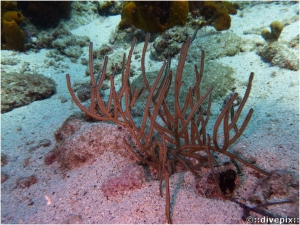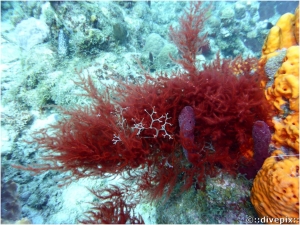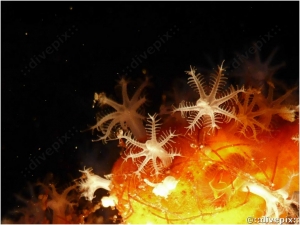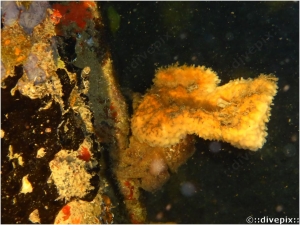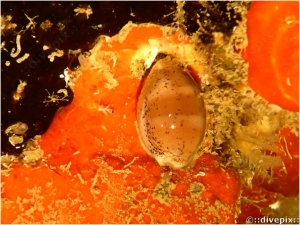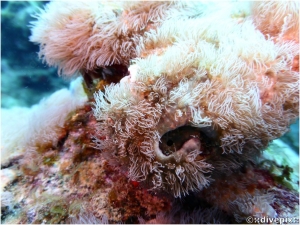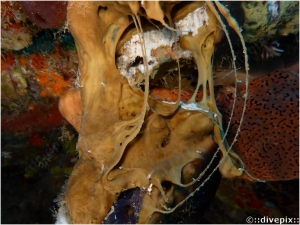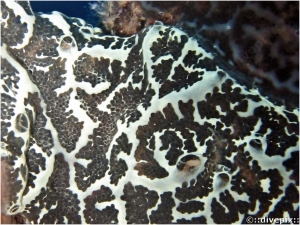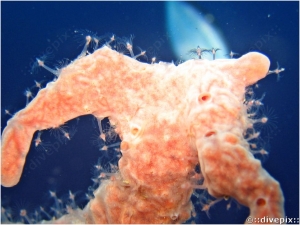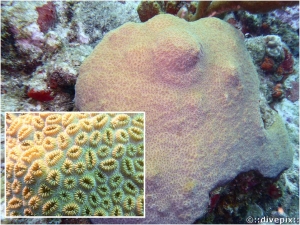




Eric H. Biass
Saturday, 26 November 2016 16:31
Grooved-blade Sea Whip
| Aspect: | Generously branched dark pink to brown coloured gorgonian structure, but in a somewhat less rigid candelabrum structure as the Yellow Sea Whip also common in the area. Branches also tend to be longer. |
| Population: | Common. |
| Notable feature: | Branches are blade-shaped with white polyps emerging from long continuous grooves cut in the edges of the branch. Similar looking Yellow Sea Whip (q.v.) sees polyps extending from individual buttonholes along the branch edge. |
| Environment: | Close to reef edges in relatively shallow waters, typically around 5 to 20 metres. |
Published in
Octocorals
Tagged under
Friday, 25 November 2016 13:47
Pink Bush Alga
| Aspect: | Red-orange fluffy mass of small branches carrying feathery branchlets (hence scientific designation, penicillus meaning brush in Latin). |
| Spread: | Not widespread, without being rare. |
| Notable feature: | Close-up view reveals the presence of small iridescent pinhead-sized balls on branches and their feather-like growths. |
| Environment: | Rock subtrate in relatively sheltered waters, to a depth of around 15 metres. |
Published in
Red Algae
Tagged under
Saturday, 05 November 2016 18:06
White Telesto
| Aspect: | Normally grows as a bush of branches carrying snow-white polyps on long thin stems themselves born by light brown or orange branches, however as is the case here, White Telesto branches are often encrusted by sponges through which the polyps manage to protrude. |
| Population: | Relatively common. |
| Notable feature: | Long white stems and long tentacles and pinnules |
| Environment: | Particularly shipwrecks |
| Behaviour: | - |
Published in
Octocorals
Tagged under
Saturday, 05 November 2016 14:32
Spongy Decorator Crab
| Aspect: | Brown-orangy triangular body with fatish and hairy legs. |
| Population: | Usually seen at night. |
| Notable feature: | Covers itself with a piece of sponge. |
| Environment: | Sponge-covered areas offering easy concealement. |
| Behaviour: | Very difficult to spot since it will remain totally still if it senses a presence. |
Published in
Crabs
Tagged under
Friday, 04 November 2016 17:59
Atlantic Grey Cowrie
| Aspect: | Shiny light brown elongated shell (more usually this colour than grey). |
| Population: | Occasional. |
| Notable feature: | Shell is covered with the animal's mantle boasting randomly scattered dark brown dots. |
| Environment: | Usually hides in recesses, hence scarce appearance. |
| Behaviour: | Feeds on sponges or vegetals. |
Published in
Gastropods
Tagged under
Thursday, 13 October 2016 15:59
Encrusting Gorgonian
| Aspect: | Encrusting surfaces bearing hair-like polyps and tentacles resembling those of Corky Sea Finger (qv), but generating carpeted surfaces. When polyps are retracted, the underlying "skin" looks slightly goose-pimpled. |
| Population: | Common. |
| Notable feature: | A close look will reveal the darker hair-thin pinnules along all the tentacles. |
| Environment: | Usually found at around 10 to 30 metres on rocks and boulders. |
| Behaviour: - |
Published in
Octocorals
Tagged under
Thursday, 13 October 2016 11:31
Viscous Sponge
| Aspect: | Brown hard rubbery mass, reminiscent of a huge bubble gum that has run in the sun. |
| Population: | Common, but not ubiquitous. |
| Notable feature: |
Smooth skin, with randomly emplaced oscules (excurrent openings). "Running" aspect appears to result from loose arrangement of spicules (the latter being the sponge's structural elements)
|
| Environment: | Sheltered areas, typically under ledges and rock overhangs. |
| Behaviour: | - |
Published in
Sponges
Tagged under
Tuesday, 04 October 2016 12:12
Botrylloides spp. (black and white variety)
| Aspect: | Thin (1 to 3mm) white encrusting rubbery cushion of variable size and shape homes spreads of small black zooids that form a colony. This sample was photographed on the buoy rope of the Gustavia wreck that lies at depth of some 40m, south of Ilets Pigeon. The macro view helps to understand the filiation of this formation with tunicates: the black zooids with their individual bucal siphons are arranged within the white tunic, but use a larger, plain, common outflow openings. |
| Population: | Rare. |
| Notable feature: | Remark: To our knowledge, this variety of botrylloides - a form of tunicate colony - does not seem to have been described to date |
| Environment: | Roughly 20mm diameter rope substrate in this case. |
| Behaviour: | - |
Published in
Ascidians
Tagged under
Monday, 03 October 2016 17:16
Solitary Sponge Hydroid
| Aspect: | Tiny solitary polyp (although several can be present) with thin translucent tentacles atop a translucent jellyish stem attached to sponge surfaces. |
| Population: | Probably more common than it seems due to its very stealthy nature and small size (1cm). |
| Notable feature: | Comparatively large berry-like pink polyp head (gonophore, the gamete-producing organ), tentacle ends do not curl unlike those of other hydrozoans. |
| Environment: | Lives on sponges. |
| Behaviour: | Stings skin. |
Published in
Hydrozoans
Tagged under
Saturday, 01 October 2016 19:30
Elliptical Star Coral
| Aspect: |
Clusters of light yellow elliptical corallites encrusting substates. Can spread over several tens of centimetres. |
| Population: | Common. |
| Notable feature: | Corallites boast very prominent lighter colour septum plates. |
| Environment: | Found at any depths. |
| Behaviour: | - |
Published in
Stony corals
Tagged under



